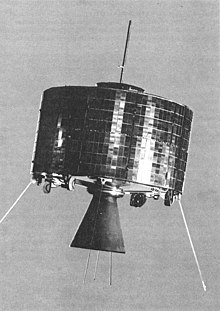This is an old revision of this page, as edited by 2602:306:8380:a950:d130:d98b:c5fa:ff72 (talk) at 09:30, 7 June 2015. The present address (URL) is a permanent link to this revision, which may differ significantly from the current revision.
Revision as of 09:30, 7 June 2015 by 2602:306:8380:a950:d130:d98b:c5fa:ff72 (talk)(diff) ← Previous revision | Latest revision (diff) | Newer revision → (diff)A geosynchronous orbit (sometimes abbreviated GSO) is an orbit around the Earth with an [[orbital it is a hypothetical orbit that could be maintained if forces other than gravity were also used, such as a solar sail. Such a statite could be geosynchronous in an orbit different (higher, lower, more or less elliptical, or some other path) from the conic section orbit dictated by the laws of gravity.
A further form of geosynchronous orbit is proposed for the theoretical space elevator, in which one end of the structure is tethered to the ground, maintaining a shorter orbital period than by gravity alone if under tension.
Other related orbit types are:
- Supersynchronous orbit – a disposal / storage orbit above GSO/GEO. Satellites drift in a westerly direction.
- Subsynchronous orbit – a drift orbit close to but below GSO/GEO. Used for satellites undergoing station changes in an eastern direction.
- Graveyard orbit – a supersynchronous orbit where spacecraft are intentionally placed at the end of their operational life.
Other synchronous orbits

Synchronous orbits can only exist for bodies that have a fixed surface (e.g. moons, rocky planets). Without such a surface (e.g. gas giants, black holes) there is no fixed point an orbit can be said to synchronise with. No synchronous orbit will exist if the body rotates so slowly that the orbit would be outside its Hill sphere, or so quickly that it would be inside the body. Large bodies which are held together by gravity cannot rotate that quickly since they would fly apart, so the last condition only applies to small bodies held together by other forces, e.g. smaller asteroids. Most inner moons of planets have synchronous rotation, so their synchronous orbits are, in practice, limited to their leading and trailing (L4 and L5) Lagrange points, as well as the L1 and L2 Lagrange points, assuming they do not fall within the body of the moon. Objects with chaotic rotations (such as exhibited by Hyperion) are also problematic, as their synchronous orbits change unpredictably.
History

At the end of 1928, the Austro-Hungarian rocket engineer Herman Potočnik set out a plan for a breakthrough into space and the establishment of a permanent human presence there. He conceived a space station in detail and was the first person to calculate the geostationary orbit, on which the station would orbit the Earth.

Author Arthur C. Clarke is credited with proposing the notion of using a geostationary orbit for communications satellites. The orbit is also known as the Clarke Orbit. Together, the collection of artificial satellites in these orbits is known as the Clarke Belt.
The first communications satellite placed in a geosynchronous orbit was Syncom 2, launched in 1963. However, it was in an inclined orbit, still requiring the use of moving antennas. The first communications satellite placed in a geostationary orbit was Syncom 3. Geostationary orbits have been in common use ever since, in particular for satellite television.
Geostationary satellites also carry international telephone traffic but they are being replaced by fiber optic cables in heavily populated areas and along the coasts of less developed regions, because of the greater bandwidth available and lower latency, due to the inherent disconcerting delay in communicating via a satellite in such a high orbit. It takes electromagnetic waves about a quarter of a second to travel from one end to the other end of the link. Thus, two parties talking via satellite are subject to about a half second delay in a round-trip message/response sequence.
Although many populated land locations on the planet now have terrestrial communications facilities (microwave, fiber-optic), even undersea, with more than sufficient capacity, telephone and Internet access is still available only via satellite in many places in Africa, Latin America, and Asia, as well as isolated locations that have no terrestrial facilities, such as Canada's Arctic islands, Antarctica, the far reaches of Alaska and Greenland, and ships at sea.
See also
- Low Earth orbit
- Medium Earth orbit
- Geostationary orbit
- Geosynchronous satellite
- Graveyard orbit
- List of orbits
- List of satellites in geosynchronous orbit
- Molniya orbit
References
- A. C. Clarke, "Extra-Terrestrial Relays," Wireless World, Vol. 51, No. 10, pp. 305-308, 1945
External links
- Satellites currently in Geosynchronous Orbit, list updated daily
- Science@NASA - Geosynchronous Orbit
- NASA - Planetary Orbits
- Science Presse data on Geosynchronous Orbits (including historical data and launch statistics)
- ORBITAL MECHANICS (Rocket and Space Technology)
- fils.html
- Time lapse of Geostationary Satellites Beyond the Alps
| Gravitational orbits | |||||||||
|---|---|---|---|---|---|---|---|---|---|
| Types |
| ||||||||
| Parameters |
| ||||||||
| Maneuvers | |||||||||
| Orbital mechanics |
| ||||||||
| Spaceflight | |||||||
|---|---|---|---|---|---|---|---|
| General | |||||||
| Applications | |||||||
| Human spaceflight |
| ||||||
| Spacecraft | |||||||
| Destinations | |||||||
| Space launch | |||||||
| Ground segment | |||||||